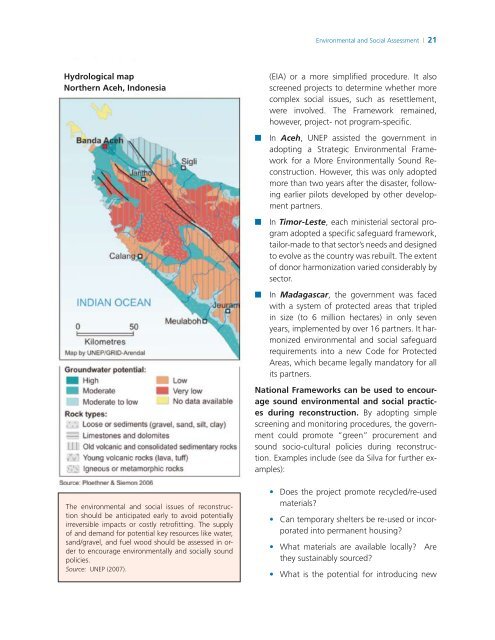Haiti Earthquake Reconstruction Knowledge Notes from ... - GFDRR
Haiti Earthquake Reconstruction Knowledge Notes from ... - GFDRR
Haiti Earthquake Reconstruction Knowledge Notes from ... - GFDRR
You also want an ePaper? Increase the reach of your titles
YUMPU automatically turns print PDFs into web optimized ePapers that Google loves.
Environmental and Social Assessment | 21<br />
Hydrological map<br />
Northern Aceh, Indonesia<br />
The environmental and social issues of reconstruction<br />
should be anticipated early to avoid potentially<br />
irreversible impacts or costly retrofitting. The supply<br />
of and demand for potential key resources like water,<br />
sand/gravel, and fuel wood should be assessed in order<br />
to encourage environmentally and socially sound<br />
policies.<br />
Source: UNEP (2007).<br />
■■<br />
■■<br />
■■<br />
(EIA) or a more simplified procedure. It also<br />
screened projects to determine whether more<br />
complex social issues, such as resettlement,<br />
were involved. The Framework remained,<br />
however, project- not program-specific.<br />
In Aceh, UNEP assisted the government in<br />
adopting a Strategic Environmental Framework<br />
for a More Environmentally Sound <strong>Reconstruction</strong>.<br />
However, this was only adopted<br />
more than two years after the disaster, following<br />
earlier pilots developed by other development<br />
partners.<br />
In Timor-Leste, each ministerial sectoral program<br />
adopted a specific safeguard framework,<br />
tailor-made to that sector’s needs and designed<br />
to evolve as the country was rebuilt. The extent<br />
of donor harmonization varied considerably by<br />
sector.<br />
In Madagascar, the government was faced<br />
with a system of protected areas that tripled<br />
in size (to 6 million hectares) in only seven<br />
years, implemented by over 16 partners. It harmonized<br />
environmental and social safeguard<br />
requirements into a new Code for Protected<br />
Areas, which became legally mandatory for all<br />
its partners.<br />
National Frameworks can be used to encourage<br />
sound environmental and social practices<br />
during reconstruction. By adopting simple<br />
screening and monitoring procedures, the government<br />
could promote “green” procurement and<br />
sound socio-cultural policies during reconstruction.<br />
Examples include (see da Silva for further examples):<br />
• Does the project promote recycled/re-used<br />
materials?<br />
• Can temporary shelters be re-used or incorporated<br />
into permanent housing?<br />
• What materials are available locally? Are<br />
they sustainably sourced?<br />
• What is the potential for introducing new

















